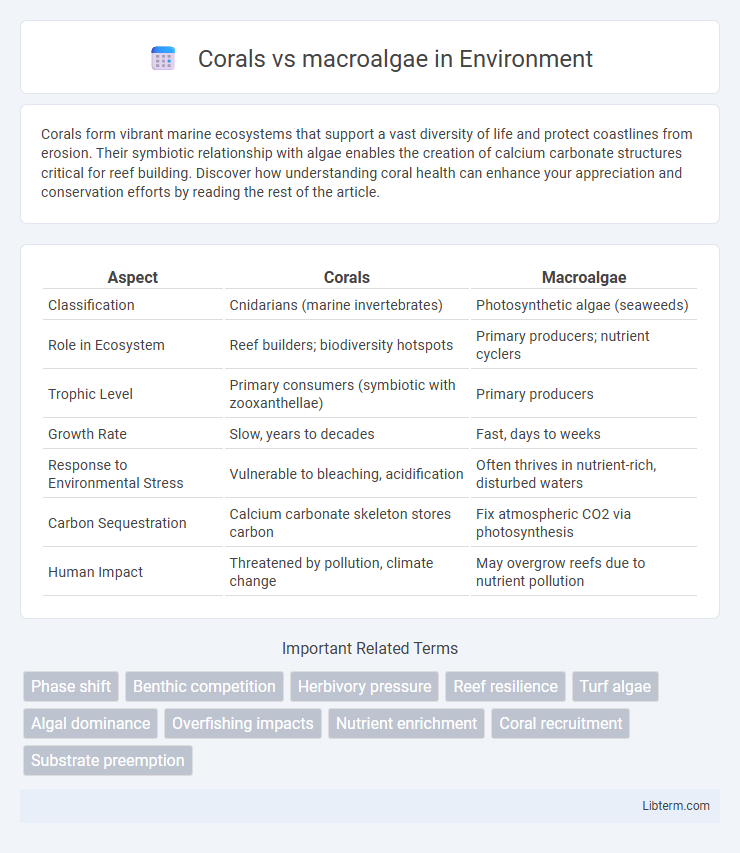Corals form vibrant marine ecosystems that support a vast diversity of life and protect coastlines from erosion. Their symbiotic relationship with algae enables the creation of calcium carbonate structures critical for reef building. Discover how understanding coral health can enhance your appreciation and conservation efforts by reading the rest of the article.
Table of Comparison
| Aspect | Corals | Macroalgae |
|---|---|---|
| Classification | Cnidarians (marine invertebrates) | Photosynthetic algae (seaweeds) |
| Role in Ecosystem | Reef builders; biodiversity hotspots | Primary producers; nutrient cyclers |
| Trophic Level | Primary consumers (symbiotic with zooxanthellae) | Primary producers |
| Growth Rate | Slow, years to decades | Fast, days to weeks |
| Response to Environmental Stress | Vulnerable to bleaching, acidification | Often thrives in nutrient-rich, disturbed waters |
| Carbon Sequestration | Calcium carbonate skeleton stores carbon | Fix atmospheric CO2 via photosynthesis |
| Human Impact | Threatened by pollution, climate change | May overgrow reefs due to nutrient pollution |
Introduction to Corals and Macroalgae
Corals are marine invertebrates belonging to the phylum Cnidaria, known for their symbiotic relationship with zooxanthellae, which provide essential nutrients through photosynthesis. Macroalgae, commonly called seaweeds, are large, photosynthetic organisms classified into three major groups: green (Chlorophyta), brown (Phaeophyceae), and red algae (Rhodophyta), playing a crucial role in coastal ecosystems. Both corals and macroalgae contribute significantly to marine biodiversity, with corals forming reef structures and macroalgae serving as primary producers and habitat providers.
Ecological Roles in Marine Ecosystems
Corals provide essential habitat structures that support high biodiversity and facilitate nutrient cycling in marine ecosystems, while macroalgae contribute significantly to primary production and carbon sequestration. Corals build calcium carbonate reefs that offer shelter for numerous marine species, promoting complex food webs and ecosystem stability. Macroalgae act as critical primary producers, supplying oxygen and serving as food sources for herbivorous marine organisms, thus maintaining ecosystem productivity and resilience.
Morphological Differences
Corals exhibit a rigid, calcium carbonate skeleton that forms complex three-dimensional structures, providing essential habitats for marine life, whereas macroalgae possess flexible, non-calcified thalli that vary in shape from flat blades to feathery filaments. Coral polyps are small, soft-bodied organisms with tentacles for capturing prey, in contrast to macroalgae, which lack true tissues and organs but have specialized cells for photosynthesis and nutrient absorption. Morphological differences influence their ecological roles, with corals contributing to reef-building and macroalgae forming extensive algal beds that can dominate benthic environments.
Coral-Macroalgae Competition Dynamics
Coral-macroalgae competition dynamics are critical in shaping reef ecosystems, where macroalgae often outcompete corals for space and resources following disturbances such as bleaching or nutrient enrichment. Elevated sea temperatures and increased nutrient levels promote macroalgal growth, which can inhibit coral recruitment and recovery by shading and releasing allelopathic compounds. Understanding these interactions is essential for reef management strategies aimed at maintaining coral dominance and ecosystem resilience.
Impact of Environmental Changes
Environmental changes such as rising sea temperatures and ocean acidification significantly disrupt the balance between corals and macroalgae, often favoring the proliferation of macroalgae. Coral bleaching events caused by thermal stress reduce coral growth and resilience, allowing macroalgae to dominate reef habitats and compete for space and resources. Nutrient enrichment from pollution exacerbates macroalgal blooms, further inhibiting coral recovery and altering reef ecosystem dynamics.
Human Activities and Habitat Shifts
Human activities such as coastal development, pollution, and overfishing accelerate habitat shifts from coral-dominated reefs to macroalgae prevalence, disrupting marine ecosystems. Nutrient loading from agricultural runoff enhances macroalgae growth, outcompeting corals for space and light, leading to coral decline. Ocean warming and acidification caused by anthropogenic emissions further stress coral resilience, facilitating macroalgal dominance and altering reef biodiversity.
Coral Reef Resilience and Recovery
Coral reef resilience is significantly influenced by the balance between corals and macroalgae, with excessive macroalgal growth often indicating ecosystem stress and hindering coral recovery by outcompeting corals for space and light. Healthy coral reefs possess mechanisms such as herbivory by fish and invertebrates that control macroalgal proliferation, promoting coral larval settlement and reef regeneration. Effective reef management strategies emphasize reducing nutrient pollution and protecting herbivore populations to maintain coral-dominated systems and enhance reef resilience and recovery.
Biodiversity and Species Interactions
Corals create complex reef structures that support high biodiversity by providing habitat, shelter, and feeding grounds for numerous marine species, promoting intricate species interactions. Macroalgae, while also offering habitat, tend to dominate degraded reefs by outcompeting corals for space and light, often reducing overall species diversity and altering trophic dynamics. The balance between corals and macroalgae influences reef resilience, with coral dominance favoring richer biodiversity and more stable ecological networks.
Conservation and Restoration Strategies
Coral reefs and macroalgae compete for space, impacting ecosystem stability, making targeted conservation and restoration strategies critical to maintaining biodiversity. Effective restoration involves coral gardening, transplanting resilient coral species, and controlling macroalgal overgrowth through herbivore protection and nutrient management. Protecting coral habitats enhances reef resilience, while managing macroalgae proliferation addresses eutrophication and supports reef recovery.
Future Outlook for Coral and Macroalgae Balance
The future outlook for coral and macroalgae balance hinges on mitigating climate change impacts and improving reef management practices that enhance coral resilience while controlling macroalgal proliferation. Advances in reef restoration, such as coral gardening and the use of herbivorous fish to graze on macroalgae, show promise in maintaining ecosystem equilibrium. Long-term monitoring and adaptive strategies integrating microbial and genetic research are critical for sustaining coral dominance amidst increasing ocean temperatures and acidification.
Corals Infographic

 libterm.com
libterm.com